Scoring Service
$139
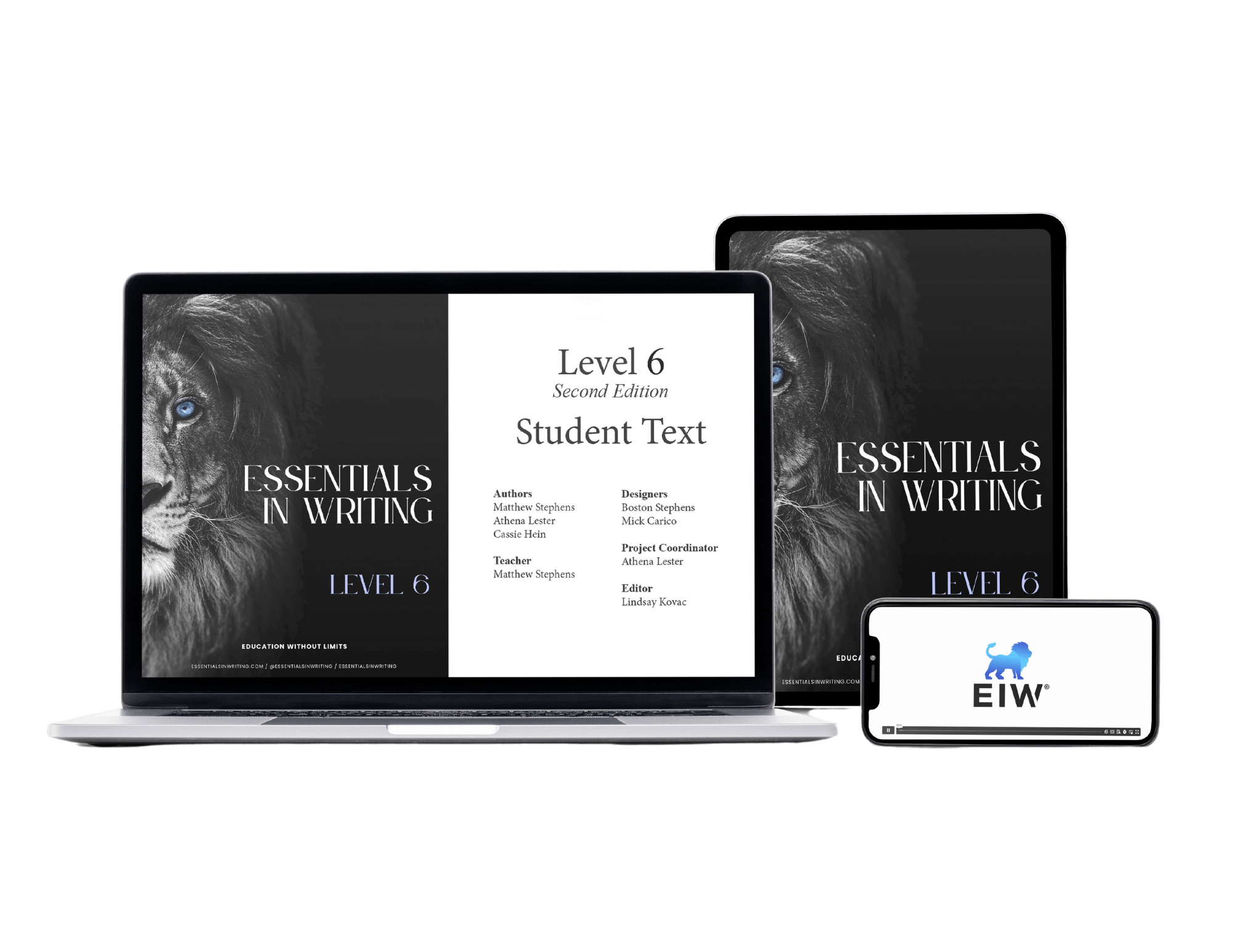
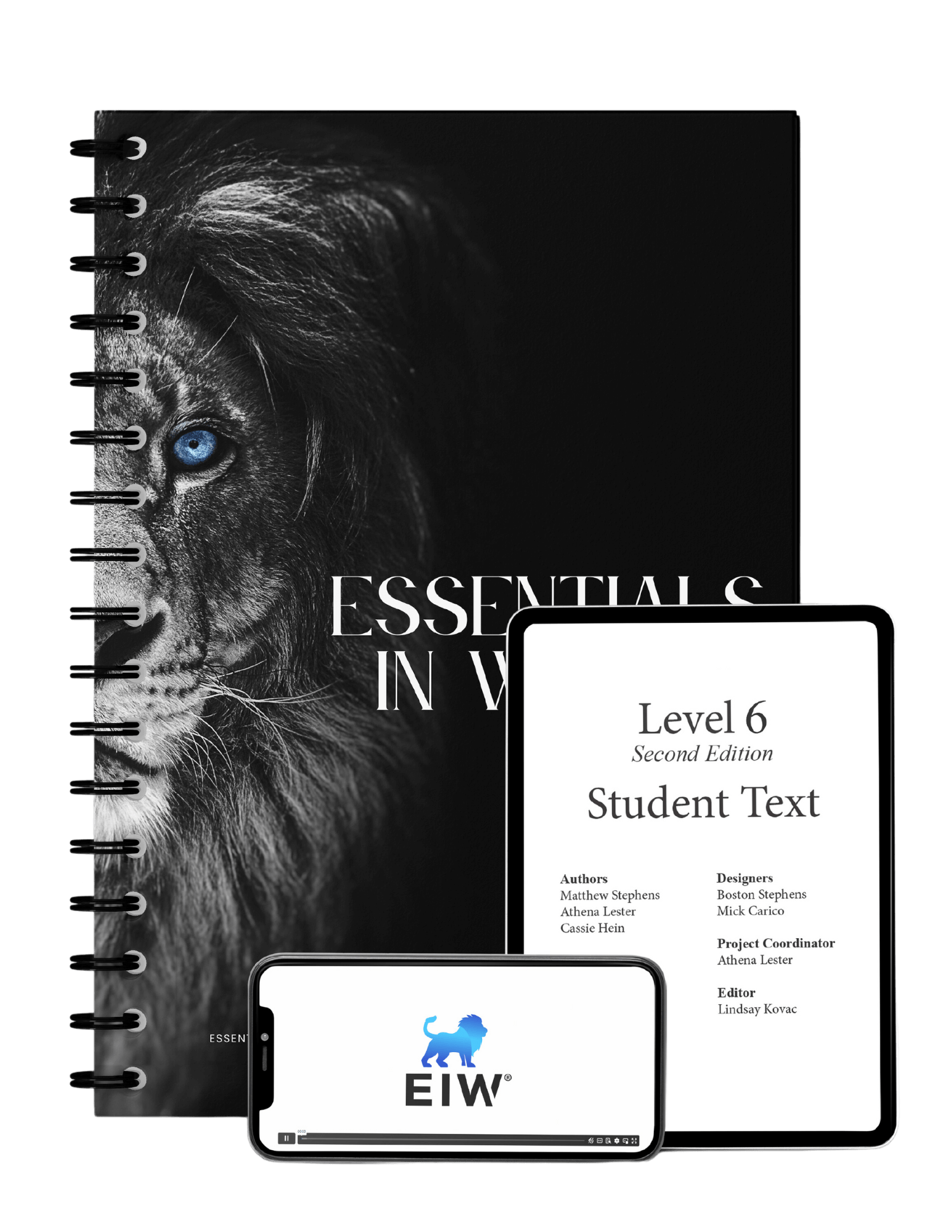
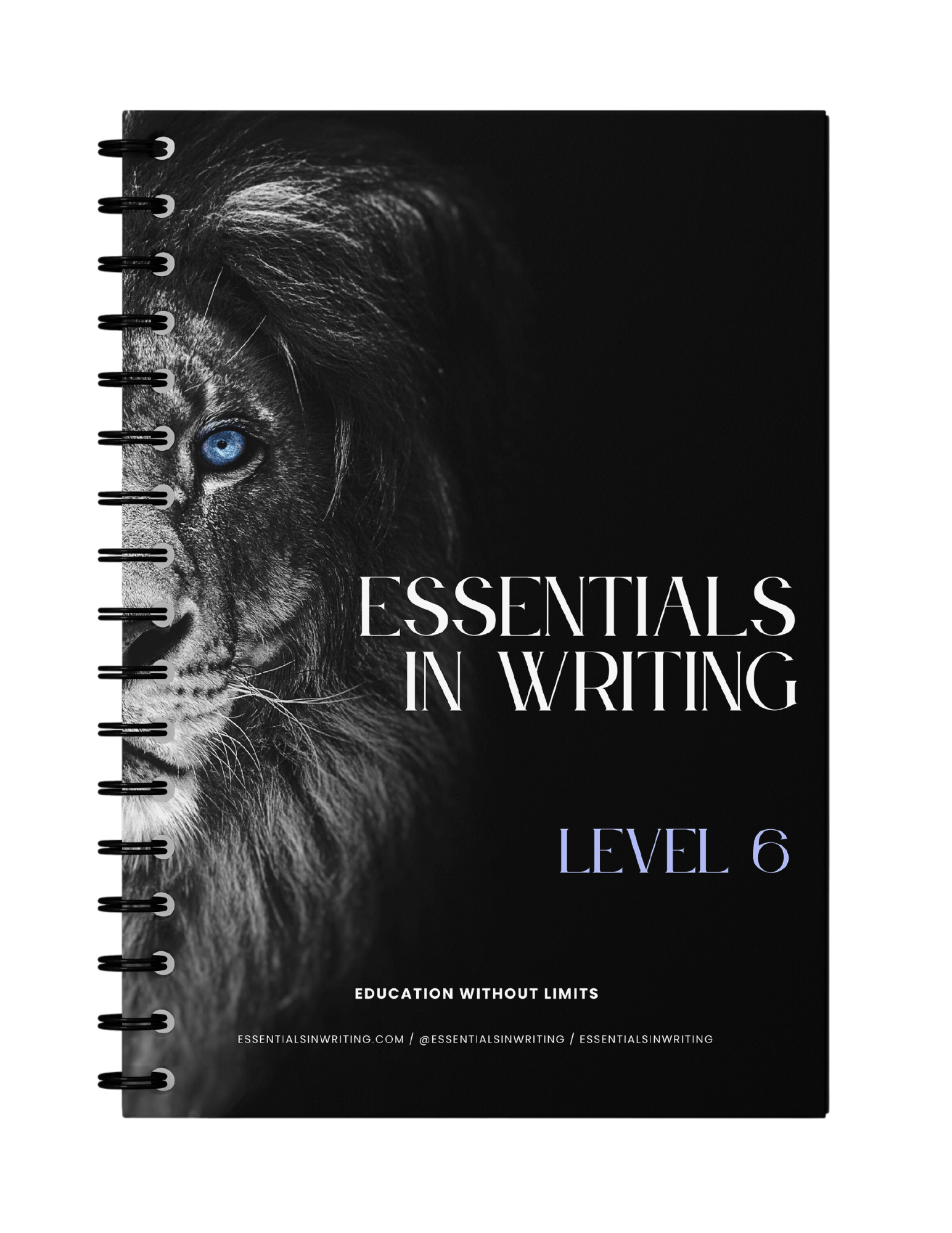

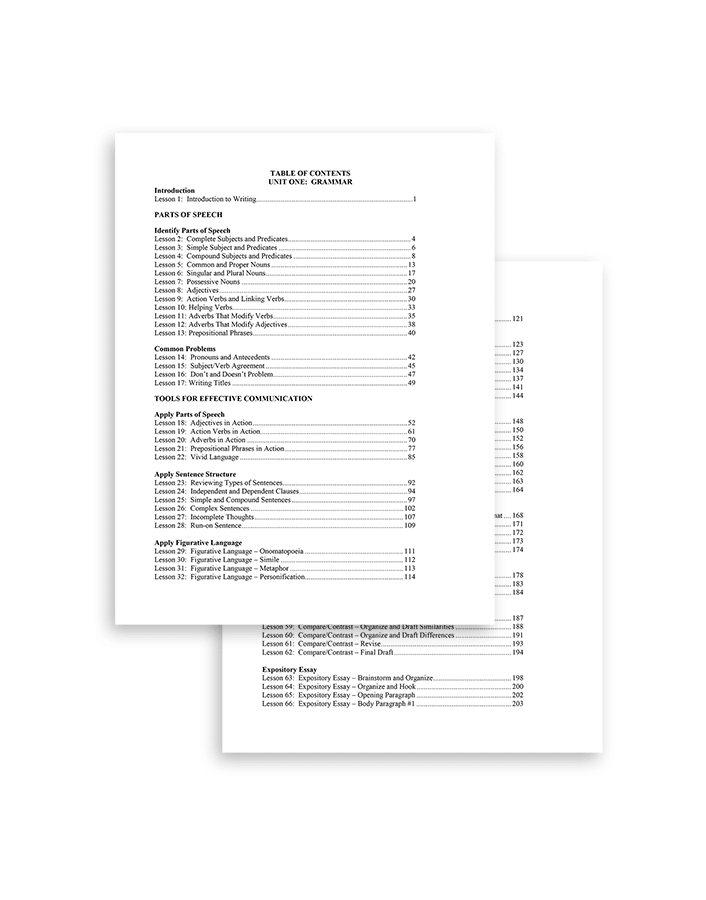
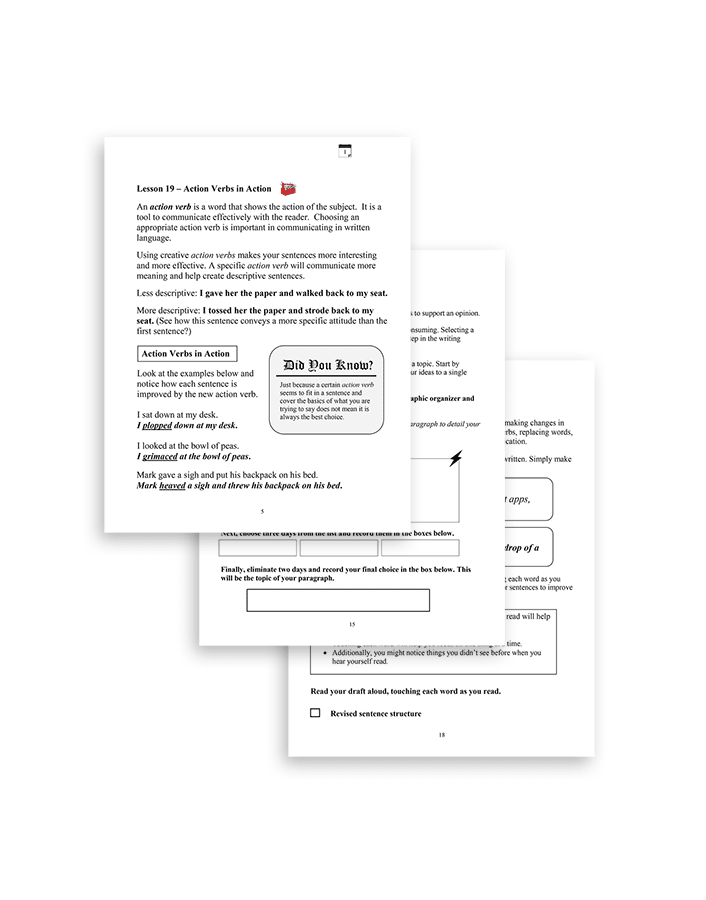






EIW™ Level 6 is a homeschool writing curriculum that features a slow, systematic approach for students aged 11-12 who want to learn how to write well. The step-by-step approach allows students to focus on small, daily assignments, so they don’t feel overwhelmed.
Order replacement student book & assessment resource books
Customers often also purchase
Scoring Service
$139
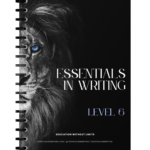
Additional Writing Student Book
$43
Scoring Service
$139
Scoring Service
$139

Additional Writing Student Books
$43

Additional ARB
$32
Scoring Service
$139
Homeschool students will learn to identify parts of speech as well as use them as tools for effective communication. They will learn to write using a variety of sentence structures in paragraphs, narratives, personal letters, essays, and a research project. Students will explore expository, descriptive, persuasive, and compare and contrast writing.

Identify and apply:
Identify and apply activities for common problems:
Tools for Effective Communication: Apply Parts of Speech
Apply Sentence Structure:
Apply Figurative Language:
Follow the writing process for:
Additional Composition Skills
Level 6 students are usually 11 years old or 12 years old. Students may be older or younger depending on if the student is a gifted writer or a struggling writer.
Level 6 writing standards will prepare students for middle school level writing. Level 6 solidifies foundational grammatical skills with more complexity and greater emphasis on application than the earlier elementary level. Students will cultivate new stylistic approaches such as developing a hook in the introduction and including dialogue in personal narrative writing to better elicit audience engagement and develop ideas with greater specificity. Students will practice working through the writing process in a variety of writing modes including narrative, persuasive, compare/contrast, descriptive, and research writing.
The EIW Level 6 curriculum consists of online video lessons, a student book, and an answer key. Parents use this homeschool writing curriculum to guide their students through grammar and writing for the 6th grade. Sixth grade students should already have a basic understanding of grammar, how to write sentences and a basic paragraph, and the basic concept of beginning, middle, and end in writing.
* A full year of language arts instruction
* Grammar instruction
* Writing instruction
* Short lessons keep students engaged
* Student-paced allows for student independence
* Includes all graphic organizers and activities
* Includes sample answers for every step of the writing process including final composition samples for each composition
* Engaging instruction
* Watch the lessons as many times as needed
* No parent teaching necessary
* Pre-made lesson planning available
* Choose how much or how little the student completes
* Focus on specific writing deficits
* Watch the lessons as many times as needed to achieve mastery
* No parent teaching necessary
* Sample writing provided for each composition to compare the student’s work to
* Lesson content that accompanies the video lesson
* Lesson activities that accompany the video lesson
* Writing graphic organizers that accompany the video lesson
* Separate parent/teacher handbook
* How to use the program
* 34-week lesson planning option
* Writing icon descriptions
* Sample answers for each lesson
* (A) Multiple choice, underline, fill-in-the-blank assessments for each mini section of the grammar unit
* (A) Composition assessments for each composition completed in the student book
* (A) Unit One and Unit Two comprehensive assessments
* (R) Extra graphic organizers
* (R) Extra writing checklists
* (R) Additional word lists
Assessment/resource book will provide students the opportunity to show what information they are retaining. Although some parents/teachers use the assessments as actual evaluations, others use them as extra practice. The additional word lists are valuable in improving student vocabulary.
Additional 6th grade writing student books can be purchased to provide a student book for another child/student. The student book does not have additional information and is just another core student book for another student so that each student has their own student book to use.
Students completing 6th grade year successfully should have mastered a number of skills and writing techniques.
* Identify and apply basic parts of speech in writing
* Identify and correct common writing problems
* Use writing techniques to communicate effectively in written language
* Identify and use a number of clauses to develop quality sentence structures
* Apply and use common figurative language in written expression
* Follow the writing process to communicate in paragraphs, narratives, letters, and essays
* Know and understand how to write in descriptive, expository, and persuasive writing
* Know and understand how to use strong details and examples to support opinions in writing
* Identify audience and purpose
* Use graphic organizers effectively to organize writing content
* Know how to choose an appropriate writing form
* Understand informal and formal writing
* Know and understand effective writing skills: strong details, transitions, beginning/middle/end concept, logical sequence of events, variety of sentence structure, effective use of dialogue, and effective use of figurative language
* Research a topic, paraphrase content, and include multiple small compositions in a research project
Unit One covers basic grammar instruction with activities where students learn to identify and apply parts of speech, to identify and correct common problems in writing, and to use parts of speech along with a variety of sentence structures and figurative language as tools for effective communication.
Unit Two covers the writing process for multiple compositions as well as how to communicate effectively in written language in a variety of styles and formats. The unit ends with a full research project.
Both units are included in the 6th grade writing curriculum student book. This book contains instructional content as well as all worksheet activities related to both units (grammar and composition). An assessment/resource book is available for purchase to accompany the student book and includes a variety of assessments in different formats as well as additional resources such as graphic organizers and word lists.
Each level of Essentials in Writing includes a 34-week suggested, yet optional, lesson planner.
The time needed to complete the 6th grade writing curriculum is a typical academic year (I.e. 34 weeks). If students follow the 34-week plan included, they will complete individual lessons and activities five days per week; however, because the lessons are broken up into small, daily mini-lessons, students can double up on some lessons and activities and complete the entire course over an academic year on a four day school week.
An answer key is presented in the back of the included Teacher Handbook. For compositions, sample answers of each step of the writing process and a final sample composition are presented to parents/teachers for comparison purposes. Checklists are included to be sure the student met the composition requirements. Parents/teachers use the checklists and sample compositions to “grade” their student’s work.

The online version of the curriculum includes all of the required materials for completing a level of Essentials in Writing or Essentials in Literature, but in a digital format. With the online version, all of your materials are in one spot within the member’s dashboard for you to view and print!
The required online materials include:
For EIW Levels 1-10, you can get a digital Assessment/Resource Booklet as well!
How does this compare to the print version? The print version of the curriculum includes all the online access to the digital materials AND the printed, physical, tangible version of the student books. The printed books are great for students who prefer to complete their assignments directly within an organized, bound book.
It simply comes down to personal preference. Now, families have the added convenience of being able to access their materials in different formats.
Additional Student Book is compatible only with second edition Essentials in Writing video instruction. This is only a Student Student Book for an ADDITIONAL student using the same level of video instruction. Please note that the Student Book is not functional without the related video instruction.

The Essentials in Writing Scoring Service is an optional add-on service that provides personal feedback and scoring of your student’s compositions! Our Scoring Team includes a variety of qualified individuals including long-time educators, librarians, and professionals with bachelor’s degrees in English, and they are ready to take the task of grading compositions off your plate.
Parents of students completing levels 6*, 7*, 8*, 9*, 10*, 11 or 12 of Essentials in Writing are eligible to purchase this service. (*Second Editions only.) Offered from September 1 to June 15 of each school year, one composition for each EIW assignment may be submitted for scoring. If purchased after September 1 start date, services still expire on June 15 the following year.
PLEASE NOTE: Scoring services are for Essentials in Writing only and are not eligible for unconditional money back guarantee.

(Assessment/Resource Booklet is compatible only with second edition Essentials in Writing curriculum)

Try it Free!
Not sure which level is right for your student? Use the Placement Test.
Not sure which level is right for your student? Use the placement test.

